Strategic Marketing Planning for Argos: A Retail Industry Analysis
VerifiedAdded on 2023/01/05
|17
|6075
|30
Report
AI Summary
This report provides a detailed strategic marketing plan for Argos, a prominent UK retail company, covering various aspects of marketing planning. The report begins with an introduction to strategic marketing planning and an overview of the retail industry, focusing on Argos. It then delves into an environmental analysis, employing PESTEL and SWOT frameworks to assess the political, economic, social, technological, legal, and environmental factors impacting Argos. The report then outlines specific, measurable, achievable, realistic, and time-bound (SMART) marketing objectives, followed by a discussion of marketing strategy selection, including the Ansoff Matrix. The report also includes a critical evaluation of the strategic importance of monitoring and control of marketing strategies. The analysis incorporates theoretical arguments, and real-world examples relevant to Argos, providing a comprehensive understanding of its marketing landscape. The report concludes with a summary of the key findings and recommendations.
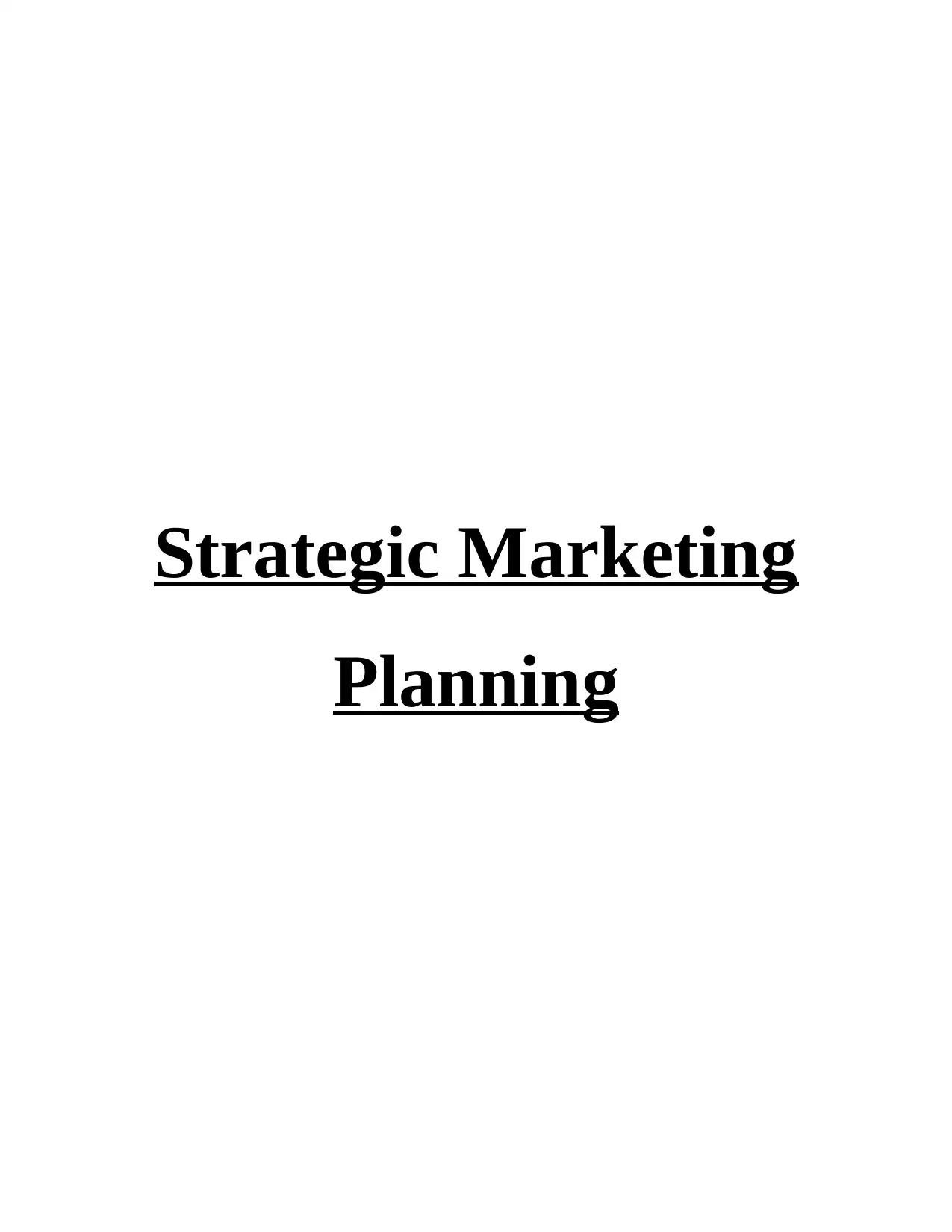
Strategic Marketing
Planning
Planning
Paraphrase This Document
Need a fresh take? Get an instant paraphrase of this document with our AI Paraphraser
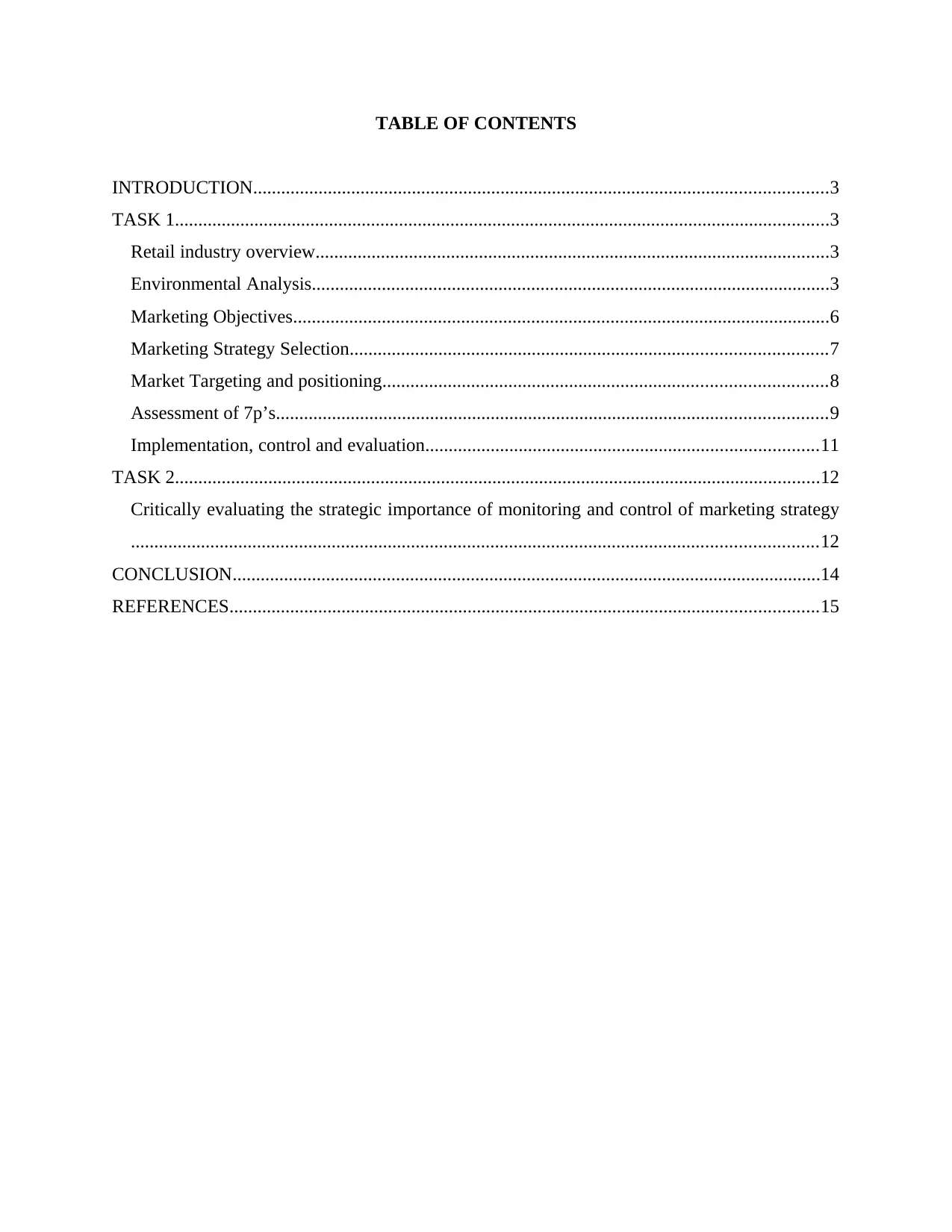
TABLE OF CONTENTS
INTRODUCTION...........................................................................................................................3
TASK 1............................................................................................................................................3
Retail industry overview..............................................................................................................3
Environmental Analysis...............................................................................................................3
Marketing Objectives...................................................................................................................6
Marketing Strategy Selection......................................................................................................7
Market Targeting and positioning...............................................................................................8
Assessment of 7p’s......................................................................................................................9
Implementation, control and evaluation....................................................................................11
TASK 2..........................................................................................................................................12
Critically evaluating the strategic importance of monitoring and control of marketing strategy
...................................................................................................................................................12
CONCLUSION..............................................................................................................................14
REFERENCES..............................................................................................................................15
INTRODUCTION...........................................................................................................................3
TASK 1............................................................................................................................................3
Retail industry overview..............................................................................................................3
Environmental Analysis...............................................................................................................3
Marketing Objectives...................................................................................................................6
Marketing Strategy Selection......................................................................................................7
Market Targeting and positioning...............................................................................................8
Assessment of 7p’s......................................................................................................................9
Implementation, control and evaluation....................................................................................11
TASK 2..........................................................................................................................................12
Critically evaluating the strategic importance of monitoring and control of marketing strategy
...................................................................................................................................................12
CONCLUSION..............................................................................................................................14
REFERENCES..............................................................................................................................15
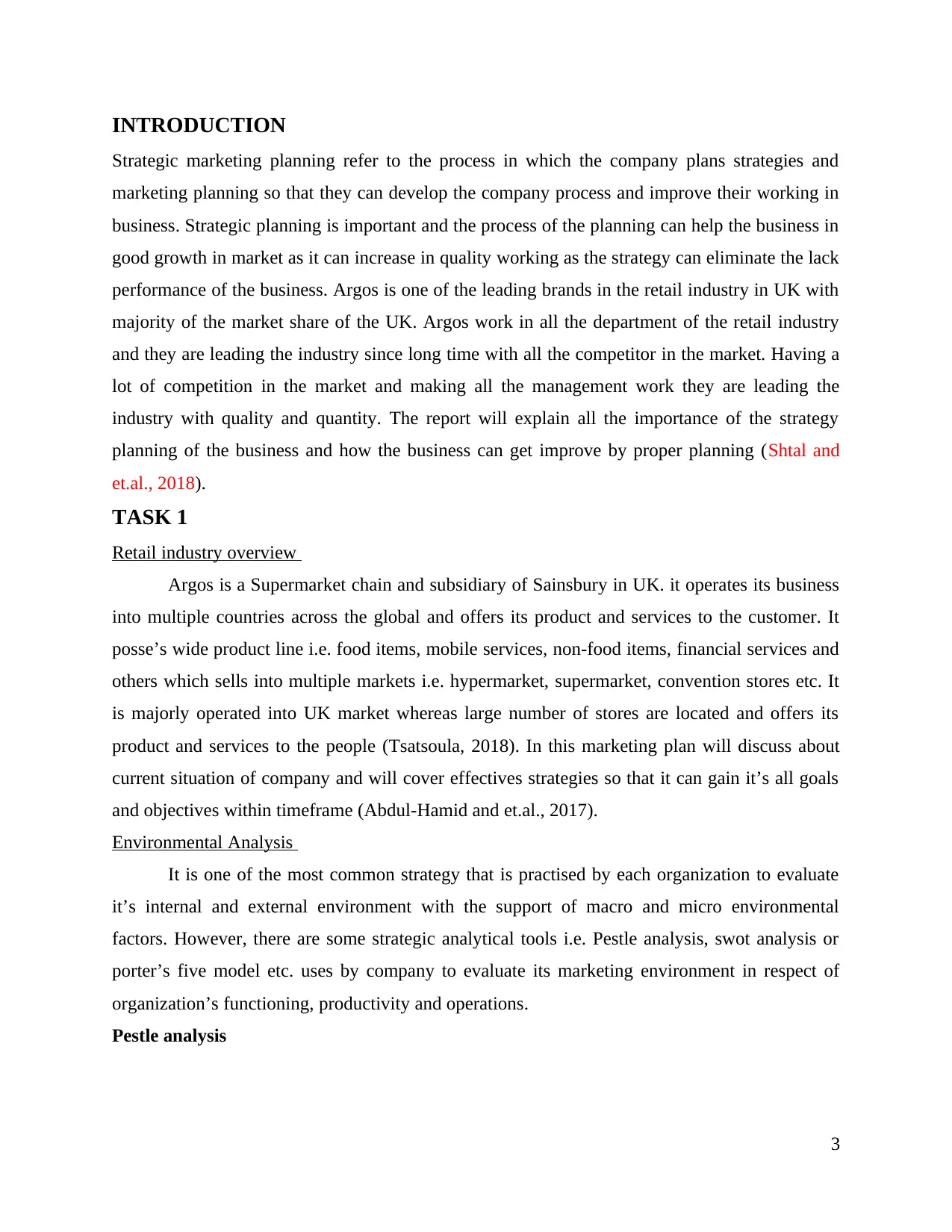
INTRODUCTION
Strategic marketing planning refer to the process in which the company plans strategies and
marketing planning so that they can develop the company process and improve their working in
business. Strategic planning is important and the process of the planning can help the business in
good growth in market as it can increase in quality working as the strategy can eliminate the lack
performance of the business. Argos is one of the leading brands in the retail industry in UK with
majority of the market share of the UK. Argos work in all the department of the retail industry
and they are leading the industry since long time with all the competitor in the market. Having a
lot of competition in the market and making all the management work they are leading the
industry with quality and quantity. The report will explain all the importance of the strategy
planning of the business and how the business can get improve by proper planning (Shtal and
et.al., 2018).
TASK 1
Retail industry overview
Argos is a Supermarket chain and subsidiary of Sainsbury in UK. it operates its business
into multiple countries across the global and offers its product and services to the customer. It
posse’s wide product line i.e. food items, mobile services, non-food items, financial services and
others which sells into multiple markets i.e. hypermarket, supermarket, convention stores etc. It
is majorly operated into UK market whereas large number of stores are located and offers its
product and services to the people (Tsatsoula, 2018). In this marketing plan will discuss about
current situation of company and will cover effectives strategies so that it can gain it’s all goals
and objectives within timeframe (Abdul-Hamid and et.al., 2017).
Environmental Analysis
It is one of the most common strategy that is practised by each organization to evaluate
it’s internal and external environment with the support of macro and micro environmental
factors. However, there are some strategic analytical tools i.e. Pestle analysis, swot analysis or
porter’s five model etc. uses by company to evaluate its marketing environment in respect of
organization’s functioning, productivity and operations.
Pestle analysis
3
Strategic marketing planning refer to the process in which the company plans strategies and
marketing planning so that they can develop the company process and improve their working in
business. Strategic planning is important and the process of the planning can help the business in
good growth in market as it can increase in quality working as the strategy can eliminate the lack
performance of the business. Argos is one of the leading brands in the retail industry in UK with
majority of the market share of the UK. Argos work in all the department of the retail industry
and they are leading the industry since long time with all the competitor in the market. Having a
lot of competition in the market and making all the management work they are leading the
industry with quality and quantity. The report will explain all the importance of the strategy
planning of the business and how the business can get improve by proper planning (Shtal and
et.al., 2018).
TASK 1
Retail industry overview
Argos is a Supermarket chain and subsidiary of Sainsbury in UK. it operates its business
into multiple countries across the global and offers its product and services to the customer. It
posse’s wide product line i.e. food items, mobile services, non-food items, financial services and
others which sells into multiple markets i.e. hypermarket, supermarket, convention stores etc. It
is majorly operated into UK market whereas large number of stores are located and offers its
product and services to the people (Tsatsoula, 2018). In this marketing plan will discuss about
current situation of company and will cover effectives strategies so that it can gain it’s all goals
and objectives within timeframe (Abdul-Hamid and et.al., 2017).
Environmental Analysis
It is one of the most common strategy that is practised by each organization to evaluate
it’s internal and external environment with the support of macro and micro environmental
factors. However, there are some strategic analytical tools i.e. Pestle analysis, swot analysis or
porter’s five model etc. uses by company to evaluate its marketing environment in respect of
organization’s functioning, productivity and operations.
Pestle analysis
3
⊘ This is a preview!⊘
Do you want full access?
Subscribe today to unlock all pages.

Trusted by 1+ million students worldwide
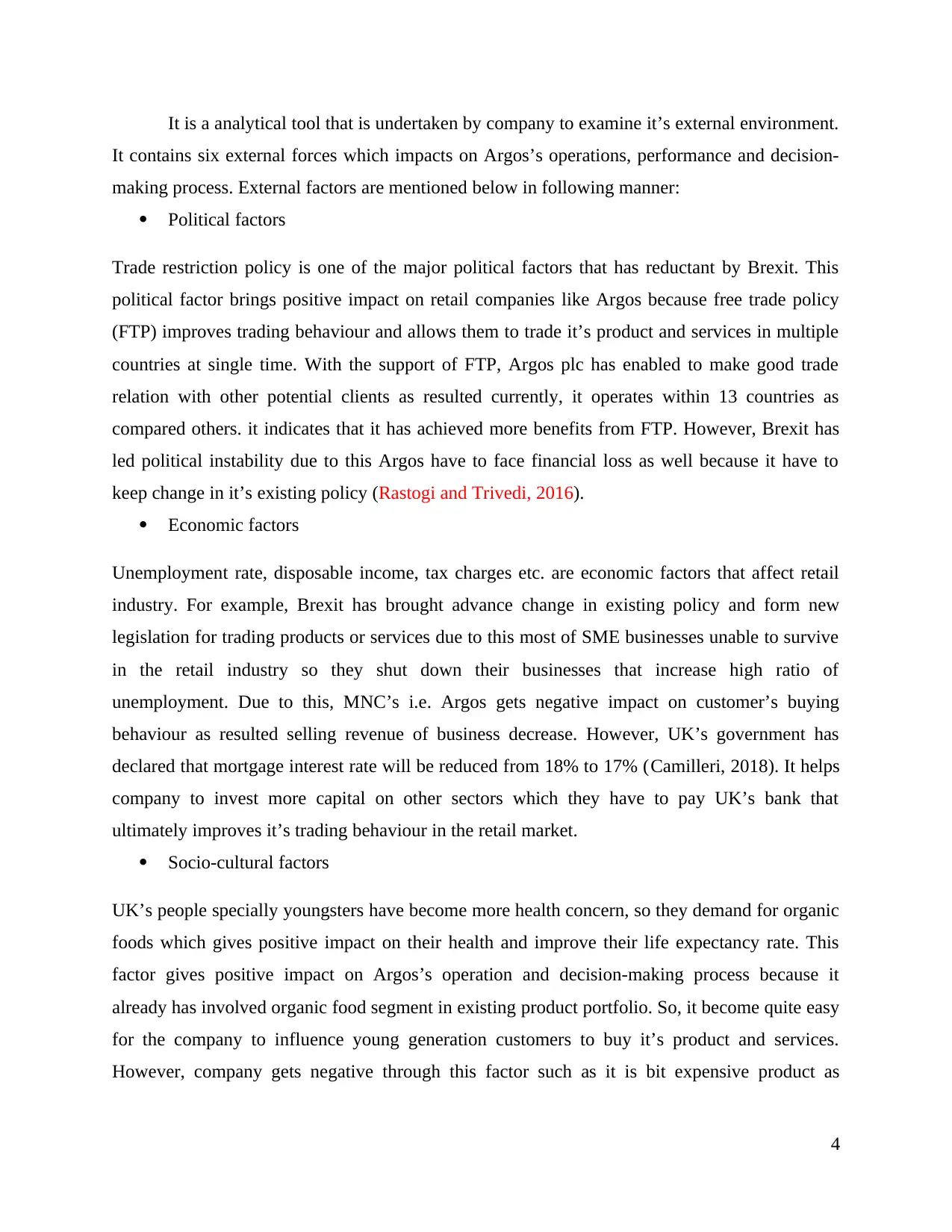
It is a analytical tool that is undertaken by company to examine it’s external environment.
It contains six external forces which impacts on Argos’s operations, performance and decision-
making process. External factors are mentioned below in following manner:
Political factors
Trade restriction policy is one of the major political factors that has reductant by Brexit. This
political factor brings positive impact on retail companies like Argos because free trade policy
(FTP) improves trading behaviour and allows them to trade it’s product and services in multiple
countries at single time. With the support of FTP, Argos plc has enabled to make good trade
relation with other potential clients as resulted currently, it operates within 13 countries as
compared others. it indicates that it has achieved more benefits from FTP. However, Brexit has
led political instability due to this Argos have to face financial loss as well because it have to
keep change in it’s existing policy (Rastogi and Trivedi, 2016).
Economic factors
Unemployment rate, disposable income, tax charges etc. are economic factors that affect retail
industry. For example, Brexit has brought advance change in existing policy and form new
legislation for trading products or services due to this most of SME businesses unable to survive
in the retail industry so they shut down their businesses that increase high ratio of
unemployment. Due to this, MNC’s i.e. Argos gets negative impact on customer’s buying
behaviour as resulted selling revenue of business decrease. However, UK’s government has
declared that mortgage interest rate will be reduced from 18% to 17% (Camilleri, 2018). It helps
company to invest more capital on other sectors which they have to pay UK’s bank that
ultimately improves it’s trading behaviour in the retail market.
Socio-cultural factors
UK’s people specially youngsters have become more health concern, so they demand for organic
foods which gives positive impact on their health and improve their life expectancy rate. This
factor gives positive impact on Argos’s operation and decision-making process because it
already has involved organic food segment in existing product portfolio. So, it become quite easy
for the company to influence young generation customers to buy it’s product and services.
However, company gets negative through this factor such as it is bit expensive product as
4
It contains six external forces which impacts on Argos’s operations, performance and decision-
making process. External factors are mentioned below in following manner:
Political factors
Trade restriction policy is one of the major political factors that has reductant by Brexit. This
political factor brings positive impact on retail companies like Argos because free trade policy
(FTP) improves trading behaviour and allows them to trade it’s product and services in multiple
countries at single time. With the support of FTP, Argos plc has enabled to make good trade
relation with other potential clients as resulted currently, it operates within 13 countries as
compared others. it indicates that it has achieved more benefits from FTP. However, Brexit has
led political instability due to this Argos have to face financial loss as well because it have to
keep change in it’s existing policy (Rastogi and Trivedi, 2016).
Economic factors
Unemployment rate, disposable income, tax charges etc. are economic factors that affect retail
industry. For example, Brexit has brought advance change in existing policy and form new
legislation for trading products or services due to this most of SME businesses unable to survive
in the retail industry so they shut down their businesses that increase high ratio of
unemployment. Due to this, MNC’s i.e. Argos gets negative impact on customer’s buying
behaviour as resulted selling revenue of business decrease. However, UK’s government has
declared that mortgage interest rate will be reduced from 18% to 17% (Camilleri, 2018). It helps
company to invest more capital on other sectors which they have to pay UK’s bank that
ultimately improves it’s trading behaviour in the retail market.
Socio-cultural factors
UK’s people specially youngsters have become more health concern, so they demand for organic
foods which gives positive impact on their health and improve their life expectancy rate. This
factor gives positive impact on Argos’s operation and decision-making process because it
already has involved organic food segment in existing product portfolio. So, it become quite easy
for the company to influence young generation customers to buy it’s product and services.
However, company gets negative through this factor such as it is bit expensive product as
4
Paraphrase This Document
Need a fresh take? Get an instant paraphrase of this document with our AI Paraphraser
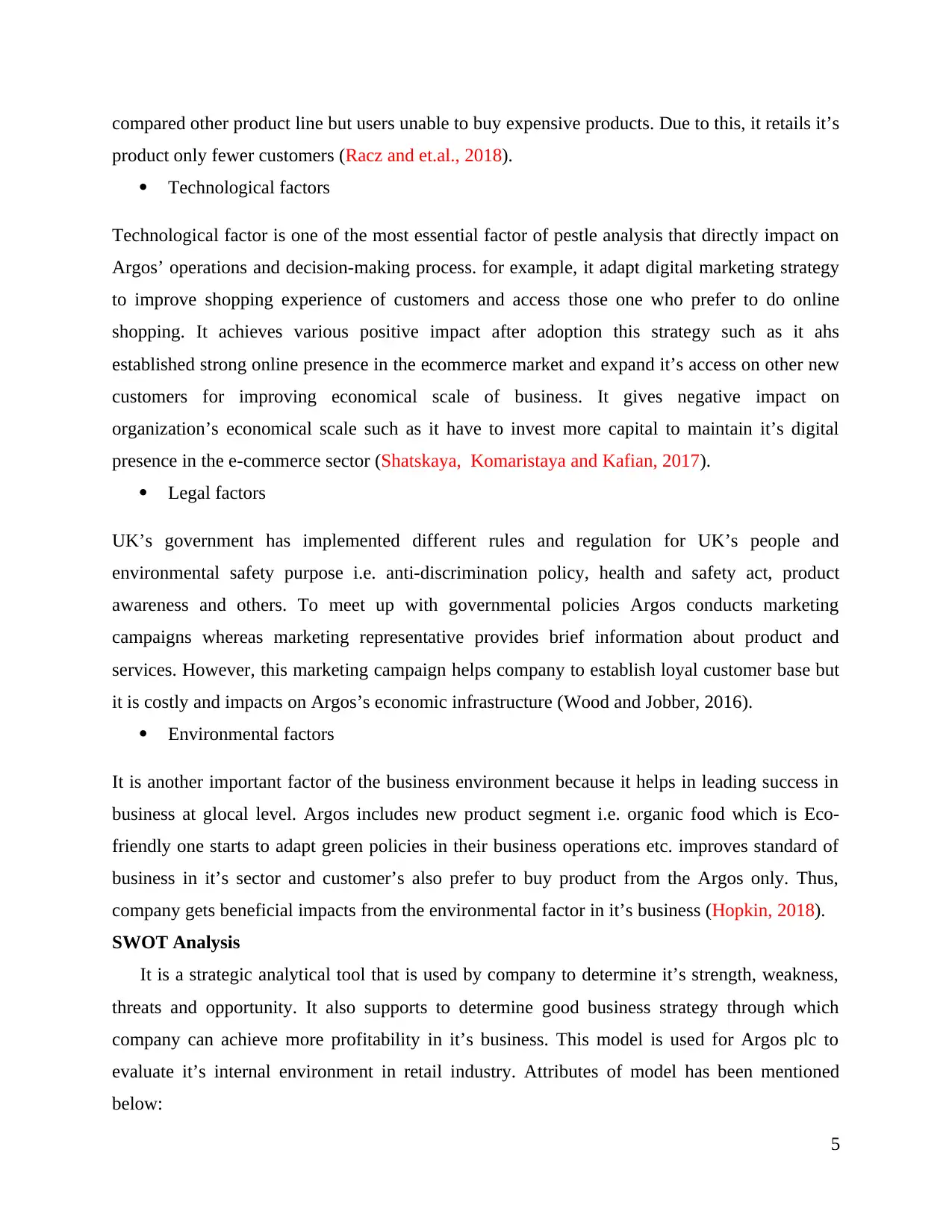
compared other product line but users unable to buy expensive products. Due to this, it retails it’s
product only fewer customers (Racz and et.al., 2018).
Technological factors
Technological factor is one of the most essential factor of pestle analysis that directly impact on
Argos’ operations and decision-making process. for example, it adapt digital marketing strategy
to improve shopping experience of customers and access those one who prefer to do online
shopping. It achieves various positive impact after adoption this strategy such as it ahs
established strong online presence in the ecommerce market and expand it’s access on other new
customers for improving economical scale of business. It gives negative impact on
organization’s economical scale such as it have to invest more capital to maintain it’s digital
presence in the e-commerce sector (Shatskaya, Komaristaya and Kafian, 2017).
Legal factors
UK’s government has implemented different rules and regulation for UK’s people and
environmental safety purpose i.e. anti-discrimination policy, health and safety act, product
awareness and others. To meet up with governmental policies Argos conducts marketing
campaigns whereas marketing representative provides brief information about product and
services. However, this marketing campaign helps company to establish loyal customer base but
it is costly and impacts on Argos’s economic infrastructure (Wood and Jobber, 2016).
Environmental factors
It is another important factor of the business environment because it helps in leading success in
business at glocal level. Argos includes new product segment i.e. organic food which is Eco-
friendly one starts to adapt green policies in their business operations etc. improves standard of
business in it’s sector and customer’s also prefer to buy product from the Argos only. Thus,
company gets beneficial impacts from the environmental factor in it’s business (Hopkin, 2018).
SWOT Analysis
It is a strategic analytical tool that is used by company to determine it’s strength, weakness,
threats and opportunity. It also supports to determine good business strategy through which
company can achieve more profitability in it’s business. This model is used for Argos plc to
evaluate it’s internal environment in retail industry. Attributes of model has been mentioned
below:
5
product only fewer customers (Racz and et.al., 2018).
Technological factors
Technological factor is one of the most essential factor of pestle analysis that directly impact on
Argos’ operations and decision-making process. for example, it adapt digital marketing strategy
to improve shopping experience of customers and access those one who prefer to do online
shopping. It achieves various positive impact after adoption this strategy such as it ahs
established strong online presence in the ecommerce market and expand it’s access on other new
customers for improving economical scale of business. It gives negative impact on
organization’s economical scale such as it have to invest more capital to maintain it’s digital
presence in the e-commerce sector (Shatskaya, Komaristaya and Kafian, 2017).
Legal factors
UK’s government has implemented different rules and regulation for UK’s people and
environmental safety purpose i.e. anti-discrimination policy, health and safety act, product
awareness and others. To meet up with governmental policies Argos conducts marketing
campaigns whereas marketing representative provides brief information about product and
services. However, this marketing campaign helps company to establish loyal customer base but
it is costly and impacts on Argos’s economic infrastructure (Wood and Jobber, 2016).
Environmental factors
It is another important factor of the business environment because it helps in leading success in
business at glocal level. Argos includes new product segment i.e. organic food which is Eco-
friendly one starts to adapt green policies in their business operations etc. improves standard of
business in it’s sector and customer’s also prefer to buy product from the Argos only. Thus,
company gets beneficial impacts from the environmental factor in it’s business (Hopkin, 2018).
SWOT Analysis
It is a strategic analytical tool that is used by company to determine it’s strength, weakness,
threats and opportunity. It also supports to determine good business strategy through which
company can achieve more profitability in it’s business. This model is used for Argos plc to
evaluate it’s internal environment in retail industry. Attributes of model has been mentioned
below:
5
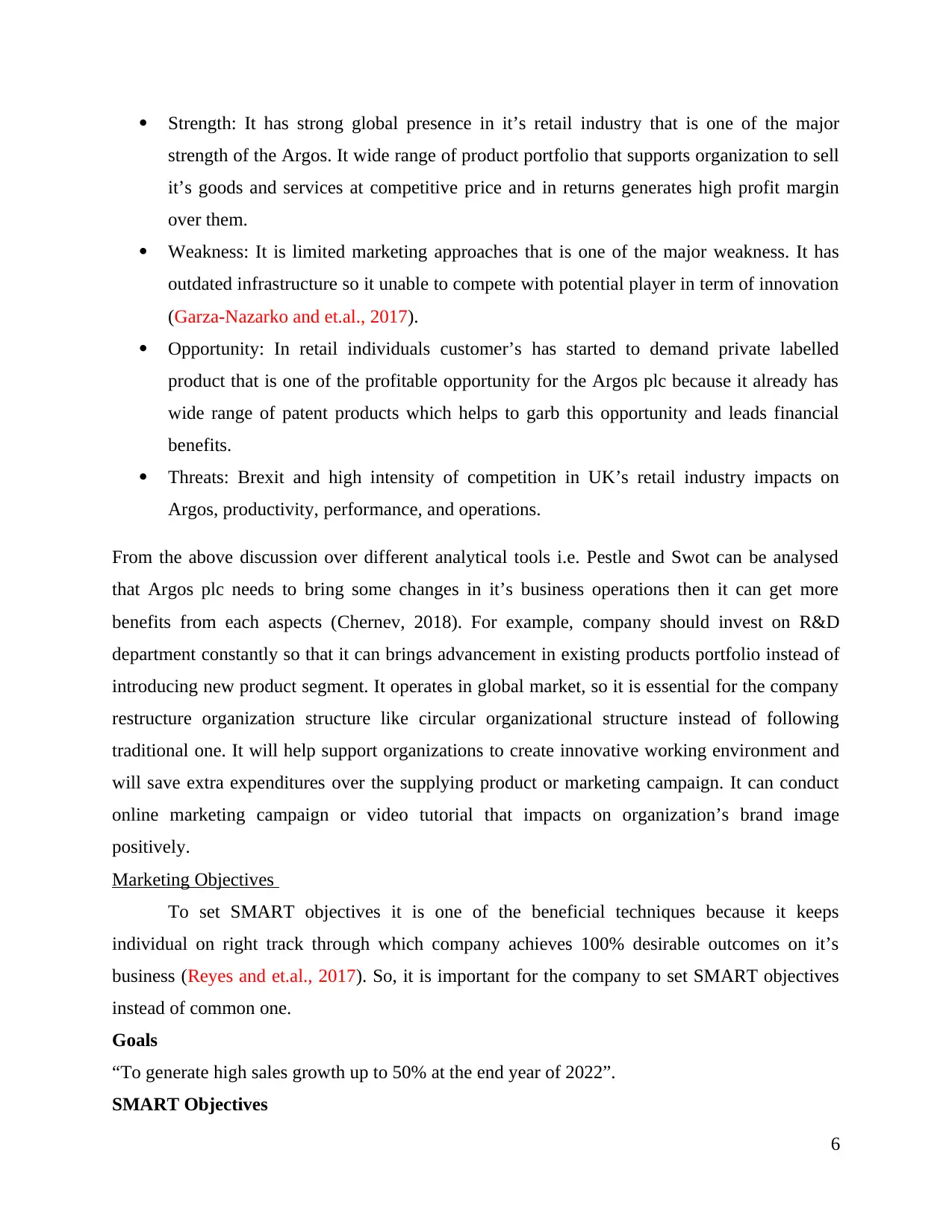
Strength: It has strong global presence in it’s retail industry that is one of the major
strength of the Argos. It wide range of product portfolio that supports organization to sell
it’s goods and services at competitive price and in returns generates high profit margin
over them.
Weakness: It is limited marketing approaches that is one of the major weakness. It has
outdated infrastructure so it unable to compete with potential player in term of innovation
(Garza-Nazarko and et.al., 2017).
Opportunity: In retail individuals customer’s has started to demand private labelled
product that is one of the profitable opportunity for the Argos plc because it already has
wide range of patent products which helps to garb this opportunity and leads financial
benefits.
Threats: Brexit and high intensity of competition in UK’s retail industry impacts on
Argos, productivity, performance, and operations.
From the above discussion over different analytical tools i.e. Pestle and Swot can be analysed
that Argos plc needs to bring some changes in it’s business operations then it can get more
benefits from each aspects (Chernev, 2018). For example, company should invest on R&D
department constantly so that it can brings advancement in existing products portfolio instead of
introducing new product segment. It operates in global market, so it is essential for the company
restructure organization structure like circular organizational structure instead of following
traditional one. It will help support organizations to create innovative working environment and
will save extra expenditures over the supplying product or marketing campaign. It can conduct
online marketing campaign or video tutorial that impacts on organization’s brand image
positively.
Marketing Objectives
To set SMART objectives it is one of the beneficial techniques because it keeps
individual on right track through which company achieves 100% desirable outcomes on it’s
business (Reyes and et.al., 2017). So, it is important for the company to set SMART objectives
instead of common one.
Goals
“To generate high sales growth up to 50% at the end year of 2022”.
SMART Objectives
6
strength of the Argos. It wide range of product portfolio that supports organization to sell
it’s goods and services at competitive price and in returns generates high profit margin
over them.
Weakness: It is limited marketing approaches that is one of the major weakness. It has
outdated infrastructure so it unable to compete with potential player in term of innovation
(Garza-Nazarko and et.al., 2017).
Opportunity: In retail individuals customer’s has started to demand private labelled
product that is one of the profitable opportunity for the Argos plc because it already has
wide range of patent products which helps to garb this opportunity and leads financial
benefits.
Threats: Brexit and high intensity of competition in UK’s retail industry impacts on
Argos, productivity, performance, and operations.
From the above discussion over different analytical tools i.e. Pestle and Swot can be analysed
that Argos plc needs to bring some changes in it’s business operations then it can get more
benefits from each aspects (Chernev, 2018). For example, company should invest on R&D
department constantly so that it can brings advancement in existing products portfolio instead of
introducing new product segment. It operates in global market, so it is essential for the company
restructure organization structure like circular organizational structure instead of following
traditional one. It will help support organizations to create innovative working environment and
will save extra expenditures over the supplying product or marketing campaign. It can conduct
online marketing campaign or video tutorial that impacts on organization’s brand image
positively.
Marketing Objectives
To set SMART objectives it is one of the beneficial techniques because it keeps
individual on right track through which company achieves 100% desirable outcomes on it’s
business (Reyes and et.al., 2017). So, it is important for the company to set SMART objectives
instead of common one.
Goals
“To generate high sales growth up to 50% at the end year of 2022”.
SMART Objectives
6
⊘ This is a preview!⊘
Do you want full access?
Subscribe today to unlock all pages.

Trusted by 1+ million students worldwide
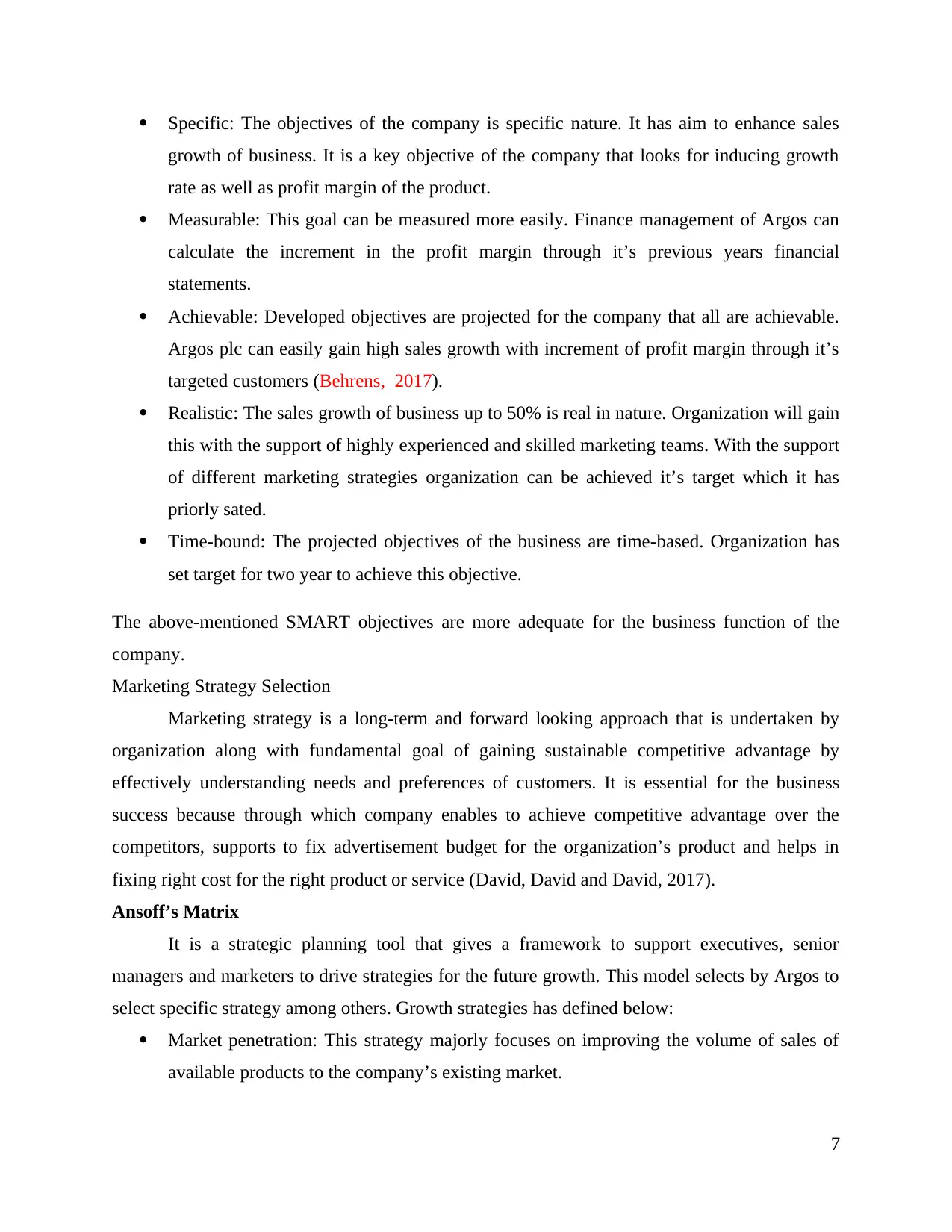
Specific: The objectives of the company is specific nature. It has aim to enhance sales
growth of business. It is a key objective of the company that looks for inducing growth
rate as well as profit margin of the product.
Measurable: This goal can be measured more easily. Finance management of Argos can
calculate the increment in the profit margin through it’s previous years financial
statements.
Achievable: Developed objectives are projected for the company that all are achievable.
Argos plc can easily gain high sales growth with increment of profit margin through it’s
targeted customers (Behrens, 2017).
Realistic: The sales growth of business up to 50% is real in nature. Organization will gain
this with the support of highly experienced and skilled marketing teams. With the support
of different marketing strategies organization can be achieved it’s target which it has
priorly sated.
Time-bound: The projected objectives of the business are time-based. Organization has
set target for two year to achieve this objective.
The above-mentioned SMART objectives are more adequate for the business function of the
company.
Marketing Strategy Selection
Marketing strategy is a long-term and forward looking approach that is undertaken by
organization along with fundamental goal of gaining sustainable competitive advantage by
effectively understanding needs and preferences of customers. It is essential for the business
success because through which company enables to achieve competitive advantage over the
competitors, supports to fix advertisement budget for the organization’s product and helps in
fixing right cost for the right product or service (David, David and David, 2017).
Ansoff’s Matrix
It is a strategic planning tool that gives a framework to support executives, senior
managers and marketers to drive strategies for the future growth. This model selects by Argos to
select specific strategy among others. Growth strategies has defined below:
Market penetration: This strategy majorly focuses on improving the volume of sales of
available products to the company’s existing market.
7
growth of business. It is a key objective of the company that looks for inducing growth
rate as well as profit margin of the product.
Measurable: This goal can be measured more easily. Finance management of Argos can
calculate the increment in the profit margin through it’s previous years financial
statements.
Achievable: Developed objectives are projected for the company that all are achievable.
Argos plc can easily gain high sales growth with increment of profit margin through it’s
targeted customers (Behrens, 2017).
Realistic: The sales growth of business up to 50% is real in nature. Organization will gain
this with the support of highly experienced and skilled marketing teams. With the support
of different marketing strategies organization can be achieved it’s target which it has
priorly sated.
Time-bound: The projected objectives of the business are time-based. Organization has
set target for two year to achieve this objective.
The above-mentioned SMART objectives are more adequate for the business function of the
company.
Marketing Strategy Selection
Marketing strategy is a long-term and forward looking approach that is undertaken by
organization along with fundamental goal of gaining sustainable competitive advantage by
effectively understanding needs and preferences of customers. It is essential for the business
success because through which company enables to achieve competitive advantage over the
competitors, supports to fix advertisement budget for the organization’s product and helps in
fixing right cost for the right product or service (David, David and David, 2017).
Ansoff’s Matrix
It is a strategic planning tool that gives a framework to support executives, senior
managers and marketers to drive strategies for the future growth. This model selects by Argos to
select specific strategy among others. Growth strategies has defined below:
Market penetration: This strategy majorly focuses on improving the volume of sales of
available products to the company’s existing market.
7
Paraphrase This Document
Need a fresh take? Get an instant paraphrase of this document with our AI Paraphraser
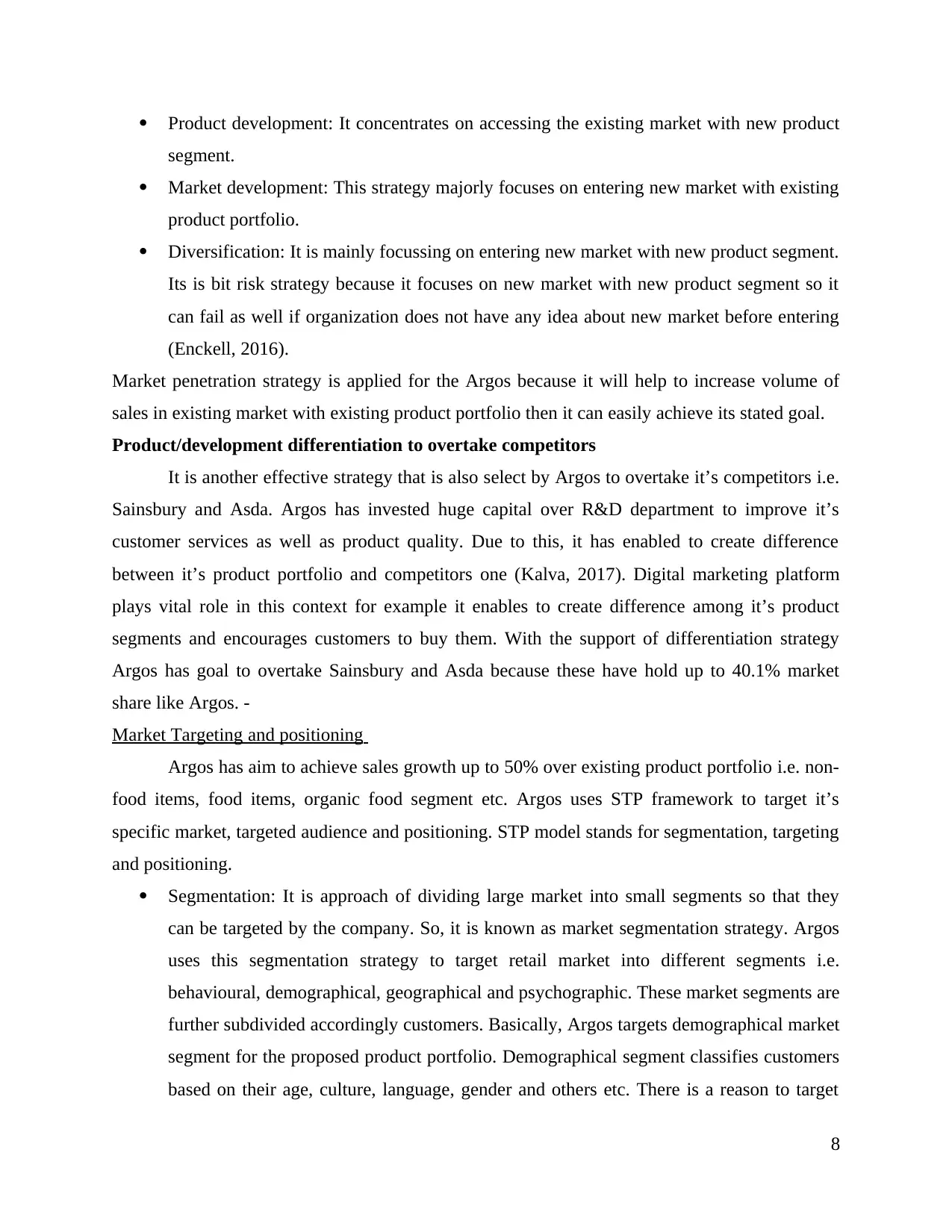
Product development: It concentrates on accessing the existing market with new product
segment.
Market development: This strategy majorly focuses on entering new market with existing
product portfolio.
Diversification: It is mainly focussing on entering new market with new product segment.
Its is bit risk strategy because it focuses on new market with new product segment so it
can fail as well if organization does not have any idea about new market before entering
(Enckell, 2016).
Market penetration strategy is applied for the Argos because it will help to increase volume of
sales in existing market with existing product portfolio then it can easily achieve its stated goal.
Product/development differentiation to overtake competitors
It is another effective strategy that is also select by Argos to overtake it’s competitors i.e.
Sainsbury and Asda. Argos has invested huge capital over R&D department to improve it’s
customer services as well as product quality. Due to this, it has enabled to create difference
between it’s product portfolio and competitors one (Kalva, 2017). Digital marketing platform
plays vital role in this context for example it enables to create difference among it’s product
segments and encourages customers to buy them. With the support of differentiation strategy
Argos has goal to overtake Sainsbury and Asda because these have hold up to 40.1% market
share like Argos. -
Market Targeting and positioning
Argos has aim to achieve sales growth up to 50% over existing product portfolio i.e. non-
food items, food items, organic food segment etc. Argos uses STP framework to target it’s
specific market, targeted audience and positioning. STP model stands for segmentation, targeting
and positioning.
Segmentation: It is approach of dividing large market into small segments so that they
can be targeted by the company. So, it is known as market segmentation strategy. Argos
uses this segmentation strategy to target retail market into different segments i.e.
behavioural, demographical, geographical and psychographic. These market segments are
further subdivided accordingly customers. Basically, Argos targets demographical market
segment for the proposed product portfolio. Demographical segment classifies customers
based on their age, culture, language, gender and others etc. There is a reason to target
8
segment.
Market development: This strategy majorly focuses on entering new market with existing
product portfolio.
Diversification: It is mainly focussing on entering new market with new product segment.
Its is bit risk strategy because it focuses on new market with new product segment so it
can fail as well if organization does not have any idea about new market before entering
(Enckell, 2016).
Market penetration strategy is applied for the Argos because it will help to increase volume of
sales in existing market with existing product portfolio then it can easily achieve its stated goal.
Product/development differentiation to overtake competitors
It is another effective strategy that is also select by Argos to overtake it’s competitors i.e.
Sainsbury and Asda. Argos has invested huge capital over R&D department to improve it’s
customer services as well as product quality. Due to this, it has enabled to create difference
between it’s product portfolio and competitors one (Kalva, 2017). Digital marketing platform
plays vital role in this context for example it enables to create difference among it’s product
segments and encourages customers to buy them. With the support of differentiation strategy
Argos has goal to overtake Sainsbury and Asda because these have hold up to 40.1% market
share like Argos. -
Market Targeting and positioning
Argos has aim to achieve sales growth up to 50% over existing product portfolio i.e. non-
food items, food items, organic food segment etc. Argos uses STP framework to target it’s
specific market, targeted audience and positioning. STP model stands for segmentation, targeting
and positioning.
Segmentation: It is approach of dividing large market into small segments so that they
can be targeted by the company. So, it is known as market segmentation strategy. Argos
uses this segmentation strategy to target retail market into different segments i.e.
behavioural, demographical, geographical and psychographic. These market segments are
further subdivided accordingly customers. Basically, Argos targets demographical market
segment for the proposed product portfolio. Demographical segment classifies customers
based on their age, culture, language, gender and others etc. There is a reason to target
8
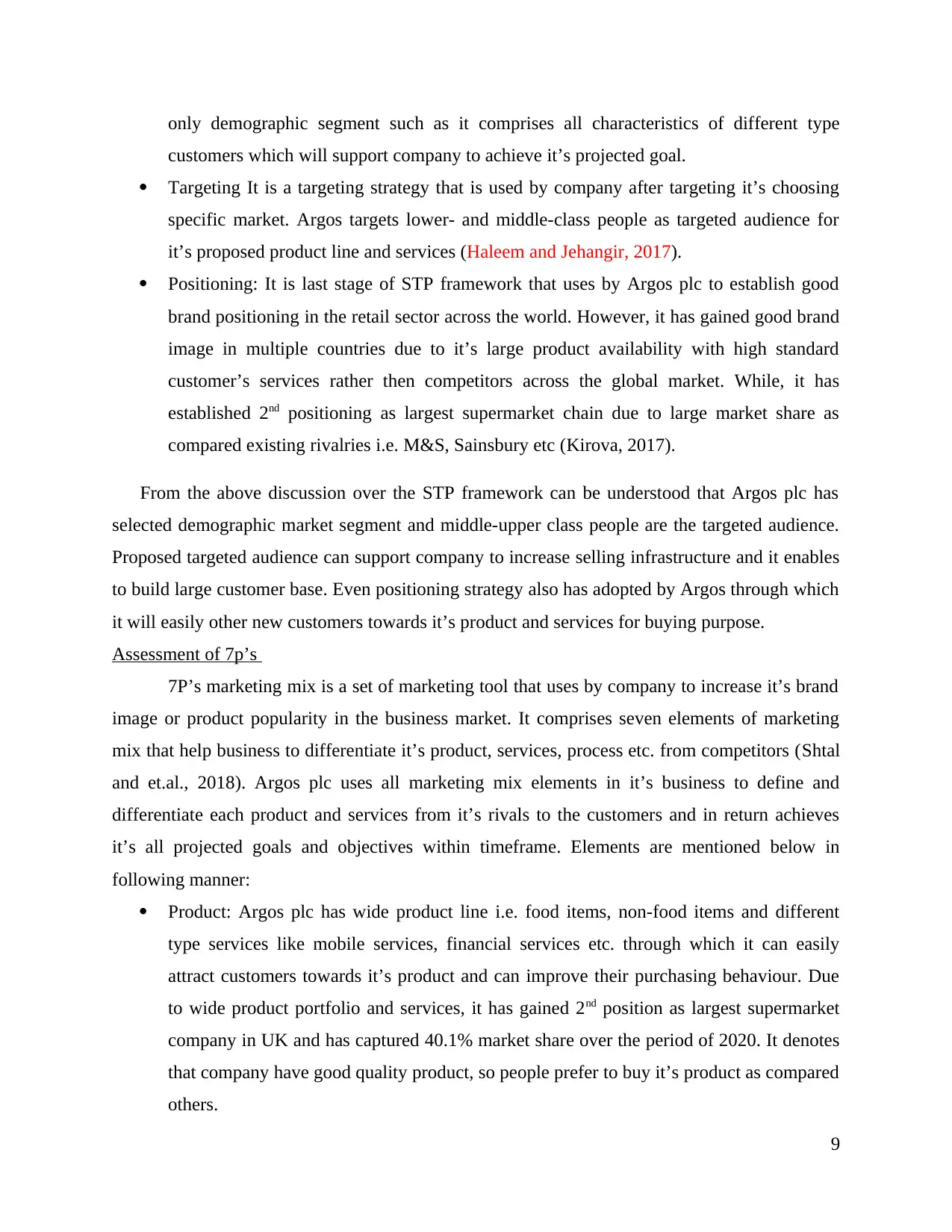
only demographic segment such as it comprises all characteristics of different type
customers which will support company to achieve it’s projected goal.
Targeting It is a targeting strategy that is used by company after targeting it’s choosing
specific market. Argos targets lower- and middle-class people as targeted audience for
it’s proposed product line and services (Haleem and Jehangir, 2017).
Positioning: It is last stage of STP framework that uses by Argos plc to establish good
brand positioning in the retail sector across the world. However, it has gained good brand
image in multiple countries due to it’s large product availability with high standard
customer’s services rather then competitors across the global market. While, it has
established 2nd positioning as largest supermarket chain due to large market share as
compared existing rivalries i.e. M&S, Sainsbury etc (Kirova, 2017).
From the above discussion over the STP framework can be understood that Argos plc has
selected demographic market segment and middle-upper class people are the targeted audience.
Proposed targeted audience can support company to increase selling infrastructure and it enables
to build large customer base. Even positioning strategy also has adopted by Argos through which
it will easily other new customers towards it’s product and services for buying purpose.
Assessment of 7p’s
7P’s marketing mix is a set of marketing tool that uses by company to increase it’s brand
image or product popularity in the business market. It comprises seven elements of marketing
mix that help business to differentiate it’s product, services, process etc. from competitors (Shtal
and et.al., 2018). Argos plc uses all marketing mix elements in it’s business to define and
differentiate each product and services from it’s rivals to the customers and in return achieves
it’s all projected goals and objectives within timeframe. Elements are mentioned below in
following manner:
Product: Argos plc has wide product line i.e. food items, non-food items and different
type services like mobile services, financial services etc. through which it can easily
attract customers towards it’s product and can improve their purchasing behaviour. Due
to wide product portfolio and services, it has gained 2nd position as largest supermarket
company in UK and has captured 40.1% market share over the period of 2020. It denotes
that company have good quality product, so people prefer to buy it’s product as compared
others.
9
customers which will support company to achieve it’s projected goal.
Targeting It is a targeting strategy that is used by company after targeting it’s choosing
specific market. Argos targets lower- and middle-class people as targeted audience for
it’s proposed product line and services (Haleem and Jehangir, 2017).
Positioning: It is last stage of STP framework that uses by Argos plc to establish good
brand positioning in the retail sector across the world. However, it has gained good brand
image in multiple countries due to it’s large product availability with high standard
customer’s services rather then competitors across the global market. While, it has
established 2nd positioning as largest supermarket chain due to large market share as
compared existing rivalries i.e. M&S, Sainsbury etc (Kirova, 2017).
From the above discussion over the STP framework can be understood that Argos plc has
selected demographic market segment and middle-upper class people are the targeted audience.
Proposed targeted audience can support company to increase selling infrastructure and it enables
to build large customer base. Even positioning strategy also has adopted by Argos through which
it will easily other new customers towards it’s product and services for buying purpose.
Assessment of 7p’s
7P’s marketing mix is a set of marketing tool that uses by company to increase it’s brand
image or product popularity in the business market. It comprises seven elements of marketing
mix that help business to differentiate it’s product, services, process etc. from competitors (Shtal
and et.al., 2018). Argos plc uses all marketing mix elements in it’s business to define and
differentiate each product and services from it’s rivals to the customers and in return achieves
it’s all projected goals and objectives within timeframe. Elements are mentioned below in
following manner:
Product: Argos plc has wide product line i.e. food items, non-food items and different
type services like mobile services, financial services etc. through which it can easily
attract customers towards it’s product and can improve their purchasing behaviour. Due
to wide product portfolio and services, it has gained 2nd position as largest supermarket
company in UK and has captured 40.1% market share over the period of 2020. It denotes
that company have good quality product, so people prefer to buy it’s product as compared
others.
9
⊘ This is a preview!⊘
Do you want full access?
Subscribe today to unlock all pages.

Trusted by 1+ million students worldwide
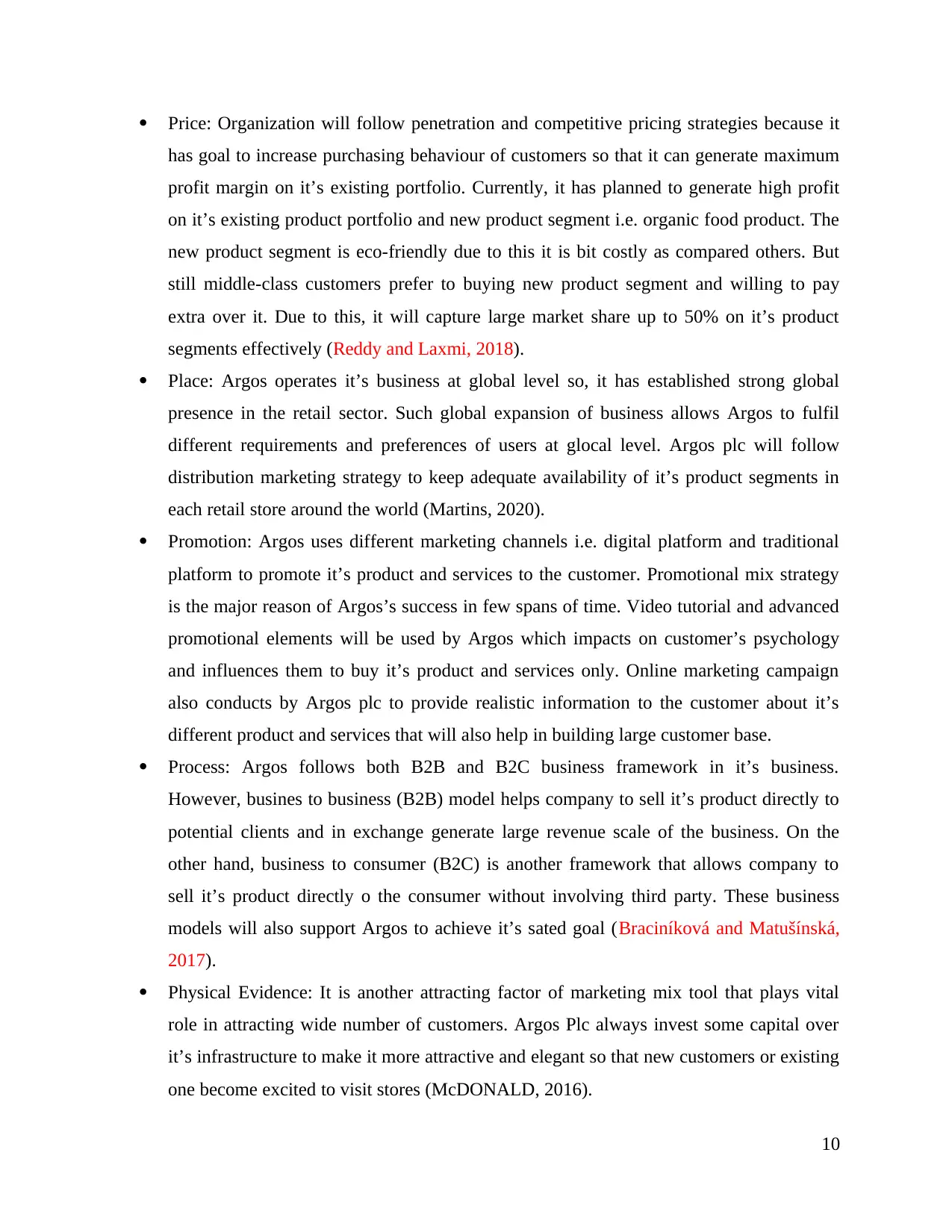
Price: Organization will follow penetration and competitive pricing strategies because it
has goal to increase purchasing behaviour of customers so that it can generate maximum
profit margin on it’s existing portfolio. Currently, it has planned to generate high profit
on it’s existing product portfolio and new product segment i.e. organic food product. The
new product segment is eco-friendly due to this it is bit costly as compared others. But
still middle-class customers prefer to buying new product segment and willing to pay
extra over it. Due to this, it will capture large market share up to 50% on it’s product
segments effectively (Reddy and Laxmi, 2018).
Place: Argos operates it’s business at global level so, it has established strong global
presence in the retail sector. Such global expansion of business allows Argos to fulfil
different requirements and preferences of users at glocal level. Argos plc will follow
distribution marketing strategy to keep adequate availability of it’s product segments in
each retail store around the world (Martins, 2020).
Promotion: Argos uses different marketing channels i.e. digital platform and traditional
platform to promote it’s product and services to the customer. Promotional mix strategy
is the major reason of Argos’s success in few spans of time. Video tutorial and advanced
promotional elements will be used by Argos which impacts on customer’s psychology
and influences them to buy it’s product and services only. Online marketing campaign
also conducts by Argos plc to provide realistic information to the customer about it’s
different product and services that will also help in building large customer base.
Process: Argos follows both B2B and B2C business framework in it’s business.
However, busines to business (B2B) model helps company to sell it’s product directly to
potential clients and in exchange generate large revenue scale of the business. On the
other hand, business to consumer (B2C) is another framework that allows company to
sell it’s product directly o the consumer without involving third party. These business
models will also support Argos to achieve it’s sated goal (Braciníková and Matušínská,
2017).
Physical Evidence: It is another attracting factor of marketing mix tool that plays vital
role in attracting wide number of customers. Argos Plc always invest some capital over
it’s infrastructure to make it more attractive and elegant so that new customers or existing
one become excited to visit stores (McDONALD, 2016).
10
has goal to increase purchasing behaviour of customers so that it can generate maximum
profit margin on it’s existing portfolio. Currently, it has planned to generate high profit
on it’s existing product portfolio and new product segment i.e. organic food product. The
new product segment is eco-friendly due to this it is bit costly as compared others. But
still middle-class customers prefer to buying new product segment and willing to pay
extra over it. Due to this, it will capture large market share up to 50% on it’s product
segments effectively (Reddy and Laxmi, 2018).
Place: Argos operates it’s business at global level so, it has established strong global
presence in the retail sector. Such global expansion of business allows Argos to fulfil
different requirements and preferences of users at glocal level. Argos plc will follow
distribution marketing strategy to keep adequate availability of it’s product segments in
each retail store around the world (Martins, 2020).
Promotion: Argos uses different marketing channels i.e. digital platform and traditional
platform to promote it’s product and services to the customer. Promotional mix strategy
is the major reason of Argos’s success in few spans of time. Video tutorial and advanced
promotional elements will be used by Argos which impacts on customer’s psychology
and influences them to buy it’s product and services only. Online marketing campaign
also conducts by Argos plc to provide realistic information to the customer about it’s
different product and services that will also help in building large customer base.
Process: Argos follows both B2B and B2C business framework in it’s business.
However, busines to business (B2B) model helps company to sell it’s product directly to
potential clients and in exchange generate large revenue scale of the business. On the
other hand, business to consumer (B2C) is another framework that allows company to
sell it’s product directly o the consumer without involving third party. These business
models will also support Argos to achieve it’s sated goal (Braciníková and Matušínská,
2017).
Physical Evidence: It is another attracting factor of marketing mix tool that plays vital
role in attracting wide number of customers. Argos Plc always invest some capital over
it’s infrastructure to make it more attractive and elegant so that new customers or existing
one become excited to visit stores (McDONALD, 2016).
10
Paraphrase This Document
Need a fresh take? Get an instant paraphrase of this document with our AI Paraphraser
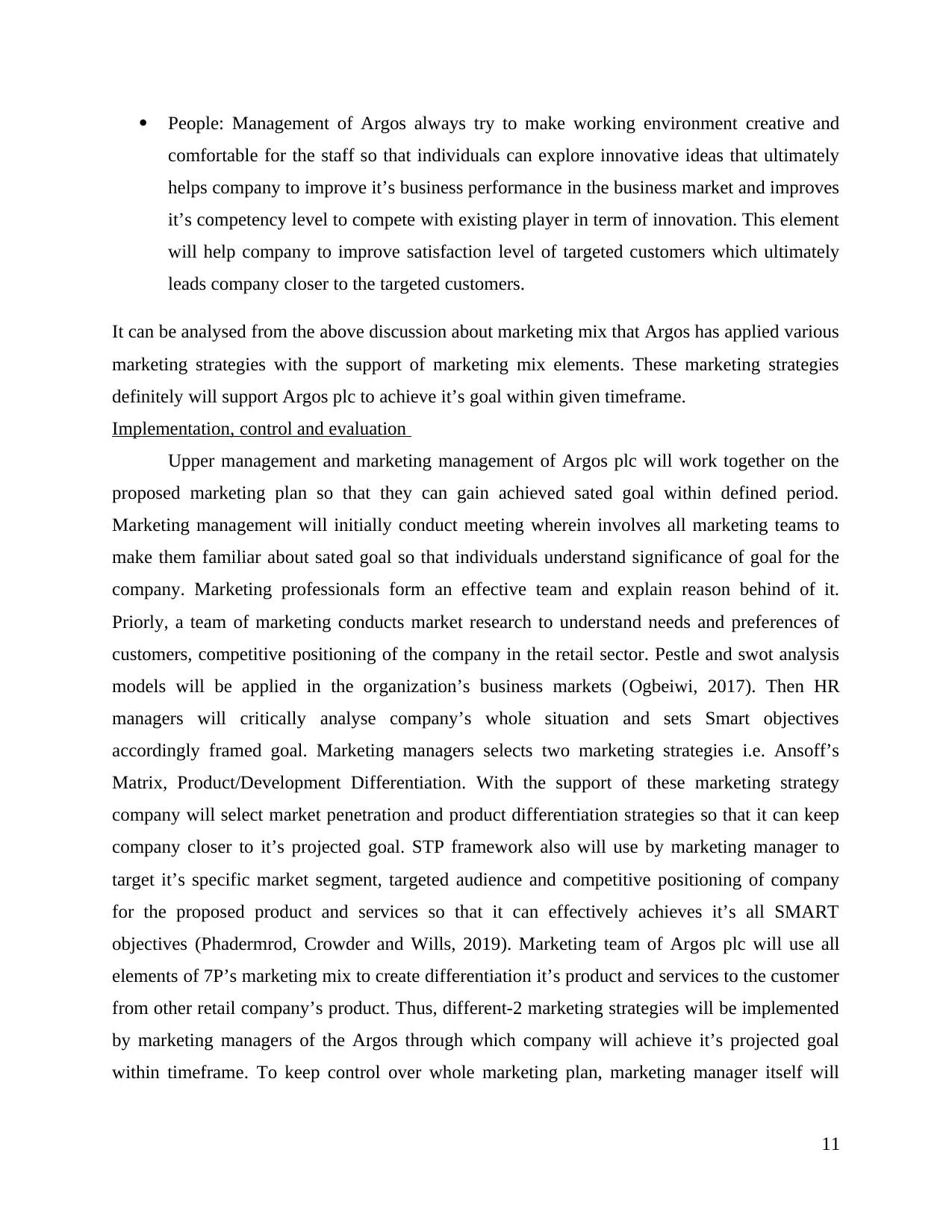
People: Management of Argos always try to make working environment creative and
comfortable for the staff so that individuals can explore innovative ideas that ultimately
helps company to improve it’s business performance in the business market and improves
it’s competency level to compete with existing player in term of innovation. This element
will help company to improve satisfaction level of targeted customers which ultimately
leads company closer to the targeted customers.
It can be analysed from the above discussion about marketing mix that Argos has applied various
marketing strategies with the support of marketing mix elements. These marketing strategies
definitely will support Argos plc to achieve it’s goal within given timeframe.
Implementation, control and evaluation
Upper management and marketing management of Argos plc will work together on the
proposed marketing plan so that they can gain achieved sated goal within defined period.
Marketing management will initially conduct meeting wherein involves all marketing teams to
make them familiar about sated goal so that individuals understand significance of goal for the
company. Marketing professionals form an effective team and explain reason behind of it.
Priorly, a team of marketing conducts market research to understand needs and preferences of
customers, competitive positioning of the company in the retail sector. Pestle and swot analysis
models will be applied in the organization’s business markets (Ogbeiwi, 2017). Then HR
managers will critically analyse company’s whole situation and sets Smart objectives
accordingly framed goal. Marketing managers selects two marketing strategies i.e. Ansoff’s
Matrix, Product/Development Differentiation. With the support of these marketing strategy
company will select market penetration and product differentiation strategies so that it can keep
company closer to it’s projected goal. STP framework also will use by marketing manager to
target it’s specific market segment, targeted audience and competitive positioning of company
for the proposed product and services so that it can effectively achieves it’s all SMART
objectives (Phadermrod, Crowder and Wills, 2019). Marketing team of Argos plc will use all
elements of 7P’s marketing mix to create differentiation it’s product and services to the customer
from other retail company’s product. Thus, different-2 marketing strategies will be implemented
by marketing managers of the Argos through which company will achieve it’s projected goal
within timeframe. To keep control over whole marketing plan, marketing manager itself will
11
comfortable for the staff so that individuals can explore innovative ideas that ultimately
helps company to improve it’s business performance in the business market and improves
it’s competency level to compete with existing player in term of innovation. This element
will help company to improve satisfaction level of targeted customers which ultimately
leads company closer to the targeted customers.
It can be analysed from the above discussion about marketing mix that Argos has applied various
marketing strategies with the support of marketing mix elements. These marketing strategies
definitely will support Argos plc to achieve it’s goal within given timeframe.
Implementation, control and evaluation
Upper management and marketing management of Argos plc will work together on the
proposed marketing plan so that they can gain achieved sated goal within defined period.
Marketing management will initially conduct meeting wherein involves all marketing teams to
make them familiar about sated goal so that individuals understand significance of goal for the
company. Marketing professionals form an effective team and explain reason behind of it.
Priorly, a team of marketing conducts market research to understand needs and preferences of
customers, competitive positioning of the company in the retail sector. Pestle and swot analysis
models will be applied in the organization’s business markets (Ogbeiwi, 2017). Then HR
managers will critically analyse company’s whole situation and sets Smart objectives
accordingly framed goal. Marketing managers selects two marketing strategies i.e. Ansoff’s
Matrix, Product/Development Differentiation. With the support of these marketing strategy
company will select market penetration and product differentiation strategies so that it can keep
company closer to it’s projected goal. STP framework also will use by marketing manager to
target it’s specific market segment, targeted audience and competitive positioning of company
for the proposed product and services so that it can effectively achieves it’s all SMART
objectives (Phadermrod, Crowder and Wills, 2019). Marketing team of Argos plc will use all
elements of 7P’s marketing mix to create differentiation it’s product and services to the customer
from other retail company’s product. Thus, different-2 marketing strategies will be implemented
by marketing managers of the Argos through which company will achieve it’s projected goal
within timeframe. To keep control over whole marketing plan, marketing manager itself will
11
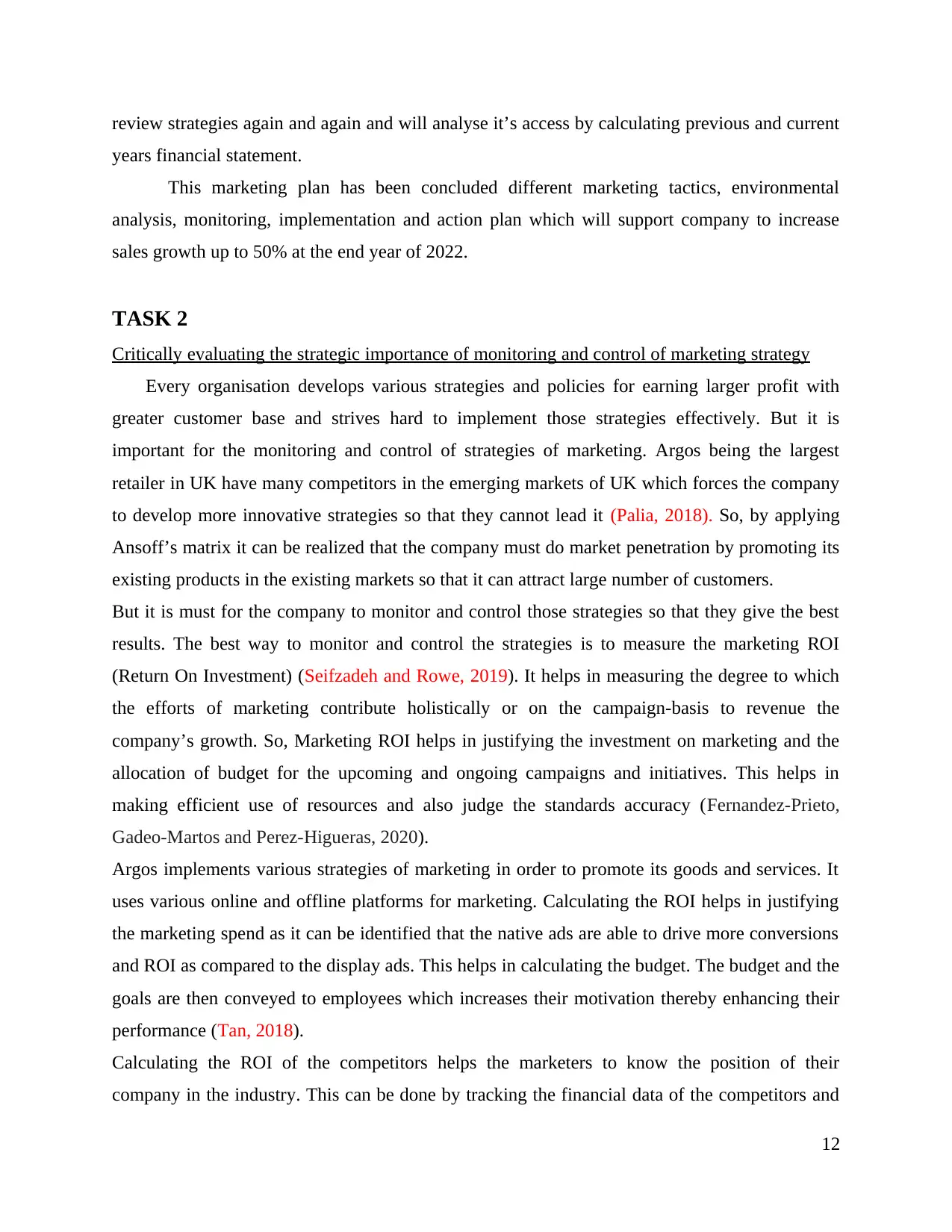
review strategies again and again and will analyse it’s access by calculating previous and current
years financial statement.
This marketing plan has been concluded different marketing tactics, environmental
analysis, monitoring, implementation and action plan which will support company to increase
sales growth up to 50% at the end year of 2022.
TASK 2
Critically evaluating the strategic importance of monitoring and control of marketing strategy
Every organisation develops various strategies and policies for earning larger profit with
greater customer base and strives hard to implement those strategies effectively. But it is
important for the monitoring and control of strategies of marketing. Argos being the largest
retailer in UK have many competitors in the emerging markets of UK which forces the company
to develop more innovative strategies so that they cannot lead it (Palia, 2018). So, by applying
Ansoff’s matrix it can be realized that the company must do market penetration by promoting its
existing products in the existing markets so that it can attract large number of customers.
But it is must for the company to monitor and control those strategies so that they give the best
results. The best way to monitor and control the strategies is to measure the marketing ROI
(Return On Investment) (Seifzadeh and Rowe, 2019). It helps in measuring the degree to which
the efforts of marketing contribute holistically or on the campaign-basis to revenue the
company’s growth. So, Marketing ROI helps in justifying the investment on marketing and the
allocation of budget for the upcoming and ongoing campaigns and initiatives. This helps in
making efficient use of resources and also judge the standards accuracy (Fernandez-Prieto,
Gadeo-Martos and Perez-Higueras, 2020).
Argos implements various strategies of marketing in order to promote its goods and services. It
uses various online and offline platforms for marketing. Calculating the ROI helps in justifying
the marketing spend as it can be identified that the native ads are able to drive more conversions
and ROI as compared to the display ads. This helps in calculating the budget. The budget and the
goals are then conveyed to employees which increases their motivation thereby enhancing their
performance (Tan, 2018).
Calculating the ROI of the competitors helps the marketers to know the position of their
company in the industry. This can be done by tracking the financial data of the competitors and
12
years financial statement.
This marketing plan has been concluded different marketing tactics, environmental
analysis, monitoring, implementation and action plan which will support company to increase
sales growth up to 50% at the end year of 2022.
TASK 2
Critically evaluating the strategic importance of monitoring and control of marketing strategy
Every organisation develops various strategies and policies for earning larger profit with
greater customer base and strives hard to implement those strategies effectively. But it is
important for the monitoring and control of strategies of marketing. Argos being the largest
retailer in UK have many competitors in the emerging markets of UK which forces the company
to develop more innovative strategies so that they cannot lead it (Palia, 2018). So, by applying
Ansoff’s matrix it can be realized that the company must do market penetration by promoting its
existing products in the existing markets so that it can attract large number of customers.
But it is must for the company to monitor and control those strategies so that they give the best
results. The best way to monitor and control the strategies is to measure the marketing ROI
(Return On Investment) (Seifzadeh and Rowe, 2019). It helps in measuring the degree to which
the efforts of marketing contribute holistically or on the campaign-basis to revenue the
company’s growth. So, Marketing ROI helps in justifying the investment on marketing and the
allocation of budget for the upcoming and ongoing campaigns and initiatives. This helps in
making efficient use of resources and also judge the standards accuracy (Fernandez-Prieto,
Gadeo-Martos and Perez-Higueras, 2020).
Argos implements various strategies of marketing in order to promote its goods and services. It
uses various online and offline platforms for marketing. Calculating the ROI helps in justifying
the marketing spend as it can be identified that the native ads are able to drive more conversions
and ROI as compared to the display ads. This helps in calculating the budget. The budget and the
goals are then conveyed to employees which increases their motivation thereby enhancing their
performance (Tan, 2018).
Calculating the ROI of the competitors helps the marketers to know the position of their
company in the industry. This can be done by tracking the financial data of the competitors and
12
⊘ This is a preview!⊘
Do you want full access?
Subscribe today to unlock all pages.

Trusted by 1+ million students worldwide
1 out of 17
Related Documents
Your All-in-One AI-Powered Toolkit for Academic Success.
+13062052269
info@desklib.com
Available 24*7 on WhatsApp / Email
![[object Object]](/_next/static/media/star-bottom.7253800d.svg)
Unlock your academic potential
Copyright © 2020–2025 A2Z Services. All Rights Reserved. Developed and managed by ZUCOL.




